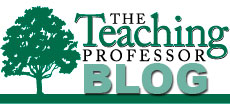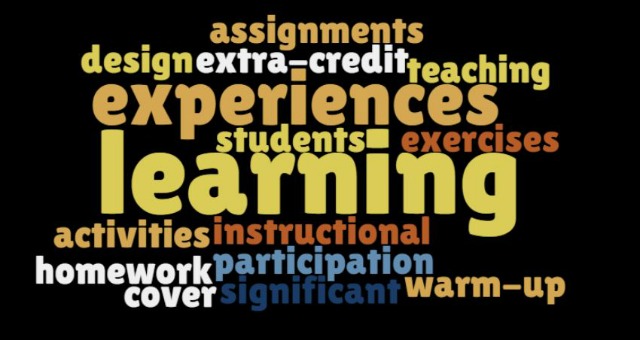Language influences thought and action. It’s a fundamental idea in linguistics. I remember first encountering it in a class when I was assigned S.I. Hayakawa’s classic Language in Thought and Action. But it’s a principle that’s easy to forget. Here are a few examples that pertain to education, with the question being—how does what we call something affect our teaching and students’ learning?
Homework – The word carries a great deal of negative baggage. How many students look forward to doing homework? “Be sure you have the homework done before you come to class.” My colleague Lolita Paff has renamed these assignments “warm-up” exercises. “They get you ready to perform really well in class.”
 Extra credit – Most teachers are opposed to extra credit—and for some good reasons. The students who ask for it the most tend to be the ones who aren’t putting much effort into the regular course work and have finally figured out they need a lifeboat. But students love extra credit—a significant number of them (sometimes it’s the vast majority) will do it, even if it counts a trivial amount. I have made the point before: homework assignments can be designed so that they require robust intellectual activity. What would happen if faculty members start thinking about extra credit as an additional assignment—a chance for students to learn important content they didn’t get the first time or an opportunity to explore material more deeply? So we call it extra credit, but it’s really another assignment—does the shift in language change our thinking?
Extra credit – Most teachers are opposed to extra credit—and for some good reasons. The students who ask for it the most tend to be the ones who aren’t putting much effort into the regular course work and have finally figured out they need a lifeboat. But students love extra credit—a significant number of them (sometimes it’s the vast majority) will do it, even if it counts a trivial amount. I have made the point before: homework assignments can be designed so that they require robust intellectual activity. What would happen if faculty members start thinking about extra credit as an additional assignment—a chance for students to learn important content they didn’t get the first time or an opportunity to explore material more deeply? So we call it extra credit, but it’s really another assignment—does the shift in language change our thinking?
Participation – For most of us the word triggers thoughts of teacher-student verbal exchanges. The teacher asks a question, one or two students raise their hands, and if not, the teacher calls on someone who might attempt a weak answer or take a pass. Participation rewards students who talk and implies that they’re the ones who are engaged. I’ve heard several faculty members say they talk about classroom engagement activities because it broadens what counts as participation. A student can be engaged by demonstrating good listening behaviors, for example.
Go over – Ask students how they plan to prepare for the upcoming exam and they will say that they’ll “go over” their notes. Ask teachers what they plan to do after the exam and they will say they’ll “go over” the most missed questions. “Go over” sounds like a high flying pass through the notes and over the questions. Wouldn’t “getting into” both be a more productive option?
Covering content – It’s such a revealing metaphor, which in reality regularly means smothering students with material. “Cover” can mean to go across, as in covering the distance between places, but it also means “concealing,” such as leaves covering the grass or the forest floor. That meaning sets up a troubling relationship between faculty and content. Shouldn’t we be using content rather than covering it? We use the content to develop a knowledge base so that students who’ve had a course on the subject know something about it. And aren’t we using the content to develop those all-important learning skills such as critical thinking, problem solving, and evidence analysis?
Instructional design – The phrase sounds fine. It means assembling the materials and activities of a course so that they accomplish specified goals and objectives. But the phrase doesn’t resonate with faculty, most of whom put their courses together with the textbook table of contents on one side and the syllabus on the other. Dee Fink came along and proposed that what faculty should be doing was creating significant learning experiences, and all of a sudden faculty caught a glimpse of what it means to be an instructional designer. When they figure out the details of an assignment, an activity, or a course, they shape the learning experiences students will be having in the course—and don’t we all want those to be significant events? Thank you, Dee!
Teaching – Until the early 1990s we focused our efforts solely on teaching. We identified characteristics of effective teachers and worked to incorporate them. Good teaching made for good learning. Then teaching was coupled with learning, and we started talking about them together. Teaching stopped existing in a sort of splendid isolation. Learning was no longer the assumed, inevitable outcome of good teaching. For many of us, our thinking made a paradigm shift. Teaching shouldn’t be the driving force. It is learning that should be energizing our instructional endeavors.
Do you have examples of common classroom expressions that we should recast? Please share below.
(c) Magna Publications. All rights reserved.

